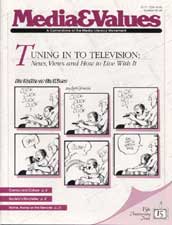STARTING POINT: Wrestling with Television -- 15 Years of Cutting Edge TV Criticism
|
This article originally appeared in Issue# 59-60
|
How Media&Values magazine helped set the stage for media literacy in the US.
There's a provocative new book currently making the rounds by a man who, aided by a host of friends with VCRs, watched all 24 hours of TV programming sent out on May 3, 1990 on the 93 channels of the nation's largest cable system.
He then compared it to the knowledge he gained from spending 24 hours on a mountain near his Adirondack home.
What we learn from TV land pales by comparison, of course, to the experience of living in the woods even for one day. But The Age of Missing Information by Bill McKibben is not just another diatribe of television-bashing.
More perceptively, he challenges the myth of television as the herald of the so-called "information revolution." "What do we really need to 'know' about the world we live in?" asks this modern Thoreau.
We may have enough facts to qualify us as candidates for Jeopardy, but can we create a life-sustaining culture and ecology, he asks, without the vital lessons of nature and face-to-face community.
Through television we are privy to both the profound and the mundane. And therein lies our struggle. How do we differentiate (and teach our young to differentiate) between what is significant and what is trivial in this seemingly endless stream of "information?"
McKibben's view of this process is full of insights not just about television but, more importantly, about ourselves. In reading it (and I do recommend it), long-time readers of Media&Values magazine may experience a satisfying sense of deja-vu.
Indeed, if you look on page 30, you'll discover a wonderful little essay by Tyrone Cashman that provides the same insight about how TV "flattens" our experiences that McKibben does. Published in our Spring 1990 issue, it was available to Media&Values readers before McKibben even embarked on his now best-selling cultural experiment.
But that's not the only cutting edge piece Media&Values published in its first 15 years. Throughout the 40 pages of this special Anniversary Issue you'll find dozens of articles, sidebars and action items that are just as relevant today as when they were first published.
Some amazingly so—such as the famous "Home, Home on the Remote" article that first spotlighted early research documenting how and why males all over the world dominate TV remote control devices. (It's still our most talked-about article.)
 Or screenwriter Dan Wakefield's thoughtful 1989 interview on television sexuality, which predated by several years the Murphy Brown debate now in vogue.
Or screenwriter Dan Wakefield's thoughtful 1989 interview on television sexuality, which predated by several years the Murphy Brown debate now in vogue.
Or Jay Davis' insightful "Five Important Ideas to Teach Your Kids about TV" which, in 1990, took the issue of children and television to a new and deeper level.
Or the classic essay on television as storyteller by media researcher George Gerbner—first published in 1981!
We chose the theme of television for this special anniversary issue because—even though Media&Values tries to cover a variety of media—television, by far, has been the most influential media force during these past 15 years.
Today television does more than just "broadcast" news and entertainment. Cable proliferates alternative media choices...on television. VCRs sell consumerism to developing cultures...on a TV screen. CNN covers the world...on television. MTV reshapes images and lifestyles...on a television music channel.
In the premiere issue of Media&Values, published in the fall of 1977, we asked, "What is this 'thing' which has intruded itself so totally on our society in less than a lifetime? How do we cope with human life in which the common values no longer seem to be articulated by the Ten Commandments, but by hundreds of thousands of TV commercials?"
Fifteen years later, we are just beginning to understand the full significance of those questions. Does this mean we've failed? That the first 15 years of Media&Values accomplished nothing?
On the contrary. In 1977, we could only vaguely identify a few obvious questions. Now in 1992, we're beginning to find some solutions to the many complex issues created by a fast-growing, consumer-based media culture.
One solution we discovered along the way is the movement for media literacy education. Pioneered in the '70s and '80s by researchers and teachers in Australia, Europe, England and Canada, media literacy education offers a new way of thinking about television and mass media and new skills of active engagement and critical reflection with the media world that surrounds us all.
We are proud that, over the past 15 years, Media&Values has been a beacon for guiding media literacy education to the U.S.
At first we thought that publishing a magazine would be enough. Then, at our 10th Anniversary, we did some long-range planning and realized more was needed. So we reorganized as the Center for Media and Values in 1989 and expanded each issue's theme into a Media Literacy Workshop Kit™ to provide simple but creative teaching/learning tools for schools, religious groups and community organizations. Last year we added videos, and future plans call for developing additional resources for both youth and adult groups.
Our goal from the beginning of Media&Values was to help define and refine the field of media education by providing a forum for discussion of the many values issues raised by a media culture: not just "sex and violence" (although these are important issues) but also the more systemic issue of the media's economic underpinning, which symbiotically drives the consumer culture.
By making obvious the connections between the global media system and our own very ordinary lives, we hoped to be able to see more clearly our way through the forest—and hopefully simplify the path for others to follow.
We are extremely grateful to the far-too-numerous-to-name writers and researchers, artists and illustrators who so generously cooperated in bringing each issue, including this one, to birth. Most freely volunteered their work. All provided invaluable contributions that not only allowed Media&Values to survive many years of being a voice in the wilderness—but more importantly, crafted a vision of something called "media awareness" into the reality of a nationwide movement for media literacy education.
Ultimately this issue is a tribute to both our writers and our readers over the years, all of them people who care...about the future of our culture...about the values that will sustain our children's children...about the strengthening of democracy everywhere in a world increasingly dominated by the mass media.
Lest we forget, however, that lectures are less effective than laughter, we begin our Anniversary Issue on Tuning in to Television with one original article. It interviews the people we consider some of today's most perceptive TV critics—the women and men who use television as a tool for commentary in their daily comic strips. As Zippy the Pinhead, Bill Griffith's media obsessed cartoon character, would say, "I view, therefore I am."



